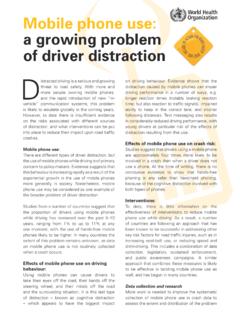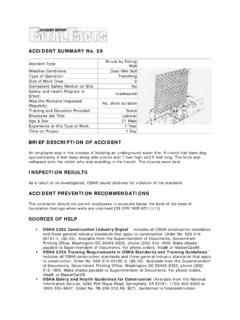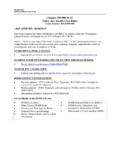Transcription of Guide to safety analysis for accident prevention
1 Guide to safety analysis for accident preventionLars Harms-RingdahlIRS Riskhantering Guide to safety analysis for accident prevention Copyright 2013 Lars Harms-Ringdahl All rights reserved. This is a non-commercial work; no content may be sold for profit or distributed without the written permission of the copyright holder. The electronic version is subject to revision; it is not permitted to put copies on the internet without the prior permission of the copyright holder. Drawings by Nils Peterson Diagrams and photos by the author Published by IRS Riskhantering AB, Bergspr ngargr nd 2A, Stockholm, Sweden ISBN 978-91-637-3164-8 The updated electronic version can be found Paperback Also available as paperback: In the Nordic countries: 3 Contents Preface 7 1 Accidents in a systems perspective 12 The accident concept 12 The size of the accident problem 16 Critical accidents 19 2 safety work and accident prevention 20 safety work 20 Elements in safety work 21 Theories and principles 25 Assumptions and priorities 32 A challenge 34 3 A framework for safety analysis 35 A starting point 35 safety analysis procedure 38 safety analysis in context 41 The probabilistic tradition 44 An accident investigation framework 47 Relationships 51 In conclusion 53 4 A brief summary of methods 54 Selection of methods 54 Types of methods 55 Examples of methods 57 Do we need more than one method?
2 59 5 Evaluation of risks and systems 61 Basics of evaluation 61 Direct Risk Evaluation 68 Quantitative evaluations 73 The Risk Matrix 76 Other evaluation approaches 84 Critical issues 86 6 Energy analysis 91 Principles 91 Energy analysis procedure 92 Example 97 Comments 100 4 7 Direct Hazard analysis 104 Principles 104 Job safety analysis 107 Example of a Job safety analysis 111 8 Deviation analysis 116 On deviations 116 Principles of Deviation analysis 118 Deviation analysis procedure 126 Examples 130 Comments 136 9 Hazop 140 Principles 140 Hazop procedure 142 Hazop example 144 Hazop comments 148 10 Fault Tree analysis 151 Introduction 151 Principles and symbols 152 Fault Tree analysis procedure 154 More on Fault Tree analysis 159 Strict and informal fault trees 165 Example of a fault tree 168 Comments 173 11 Barriers and safety functions 176 The analysis of safety 176 Barrier concepts and methods 177 Concept of safety function 181 safety Function analysis 185 Evaluation of SFs 189 Improvements to safety functions 196 Example 198 12 Some further methods 204 Introduction 204 Failure Mode and Effects analysis 206 Event Tree analysis 208 Cause-Consequence Diagrams 211 Human error methods 213 Task analysis 217 Management-oriented methods 219 Coarse analyses 224 5 13 Methods for event analysis 228 Introduction 228 STEP 232 Simple Event Mapping 235 The AEB method 239 Events and Causal Factors analysis 242 MTO analysis 244 AcciMap 247 Change
3 analysis 254 Deviation analysis of events 255 safety Function analysis of events 259 Tree analysis of events 262 14 Planning and implementation 264 Decisions before the analysis 264 Performing the analysis 268 Improvements and conclusions 270 Reporting and decisions 273 Quality aspects 274 15 Choice and summary of methods 277 Basic considerations 277 Methods of system analysis 278 Methods of event analysis 283 Methods of evaluation 288 Choosing method 291 16 Examples of safety analysis 295 Introduction 295 analysis of incidents in hospital care 296 Household gas fire 301 accident investigation at a workshop 306 safety analysis at a workshop 309 safety analysis of a school kitchen 314 safety analysis at a medical care centre 319 safety analysis of an outdoor convention 323 analysis at a pharmaceutical company 326 17 Concluding remarks 332 18 References 333 19 Index 345 6 7 Preface This book is about safety analysis as a tool for accident prevention .
4 The methods can be used to analyse systems and to investigate accidents, and thereby generate knowledge for systematic improvements. The prevention of accidents is an extensive and complex subject. In the accident prevention arena, many practices and theories exist side by side. There are different traditions involved in explaining accidents, and investigating, and preventing them. The variations are not necessarily problematic, but they suggest that accident prevention in practice is not as efficient as it could be. The variety is fascinating in many ways, and I have had the opportunity to see it from different perspectives and in various roles. Over the years, I have had the privilege to work with safety in a number of fields.
5 At the beginning, it was in the industrial sector, including paper mills, and the engineering, chemical, and pharmaceutical industries, where the focus was on occupational accidents. In stages, my scope has widened to encompass other areas, and it has been interesting to test the arsenal of industry-based methods in new settings. Examples are: Power production Railway and other transportation Hospital care Emergency services safety work at societal level There are many similarities between safety analyses and accident investigations, and often similar methods can be applied. It is also possible to apply a general methodology that can be efficiently applied in many different sectors. This has been one of my motives in attempting to write a generalised description of safety analysis and how it can be applied.
6 safety analysis safety analysis is a central concept in this book, and it is here defined as a procedure for analysing systems in order to identify and evaluate hazards and safety characteristics. The definition is wide, and covers many ways of analysing. It includes quantitative and qualitative risk analyses, accident investigations, and also some other applications. The rationale for this wide scope will be discussed further on. 8 Guide to safety analysis safety analysis can be used to: Support efficient accident prevention . Contribute to an understanding of how accidents can occur at the specific workplace under examination. Increase awareness and communication. Demonstrate systematic safety work. About this book The aim of this book is to explain general methods of safety analysis , which can be used for accident prevention in different fields.
7 The idea is to give simple straightforward descriptions, and relate them to practical experiences. The ambition is to promote wider use of the methodology, which offers a potential for better accident prevention . The book builds further on earlier publications (Harms-Ringdahl, 1987, 1993, 2001), which had a focus on occupational accidents. The material has been developed from the specialised literature, and from the author s own work on the analysis and prevention of accidents. Many important lessons have been learned from teaching on training courses in safety analysis and accident investigation. The most obvious feature of the new book is that it will be published as an electronic book that is free to download.
8 The reason for this is that it will make for a larger circulation, which will spread the methodology more widely. There will be no economic obstacles to looking at the book, and if it is found useful, it can be applied directly. There are other advantages to having an electronic version, since you can easily search and jump between pages. The use of links makes it easy to look at other references. But some people prefer paper versions, and it is possible to obtain a print-on-demand version. General comments The ambition has been to be general in descriptions, since the principles of many methods can be applied to different types of systems. This might make the descriptions harder to follow, but, on the other hand, it makes the methodology more general applicable.
9 The book suggests a general framework for accident prevention and safety analysis . Several methods of analysis will be described. Some selected methods are thoroughly described and practical suggestions given almost like in a cookbook. The intention is that the reader should get sufficient advice to perform a fairly good analysis on the basis of the description. Preface 9 The general perspective means that the methodology can be applied to a variety of systems and situations where safety is an important issue. They may concern a mechanical workshop, a ward at a hospital, or children in a school.
10 They all have it in common that some kind of organised activity is involved. The word company comes up throughout the book, and this should usually be interpreted in a wide sense. It refers to any type of organised activity in the public or private sector. safety analyses and accident investigations have many common features, which will be further explained in the framework discussion (Chapter 2). Both approaches can be applied: To identify problems and hazards in a given situation, , in a workplace To understand how a situation can be made safer To develop safety improvements To be important tools for safety management within the organisation The basic idea underlying the book is to show how safety analysis can be practically applied.








